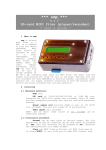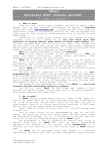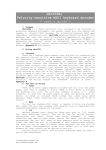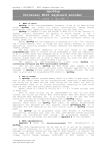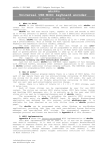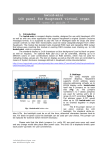Download hwlcd4 User Manual
Transcript
hwlcd4 MIDI Gadgets Boutique p.1 hwlcd4 LCD status display system for Hauptwerk virtual pipe organ * user’s guide * 1. Introduction The hwlcd4 is compact single-/dual-display module, especially designed for using with Hauptwerk 4 or any other application that supports Hauptwerk’s original System Exclusive messages format. It can control one or two standard 2x16 LCD panels, each displaying various parameters/information, coming from Hauptwerk. In addition, there is RGB full-color LED with userassignable function per each of LCD panels. The user can re-configure at any moment all user-configurable parameters by means of simple programming utility, available for free download. The configuration data is uploaded via specific SysEx message described in Appendix A. The communication between hwlcd4 and the World goes thru standard MIDI input and output. The unit requires external power supply of 12V AC/DC. Any information below related to Hauptwerk has been taken from the original Hauptwerk User Guide. 2. Firmware The firmware of hwlcd4 includes three separate software modules, running independently and simultaneously, each processing specific stream of MIDI messages in real time. The user can choose which part of which stream is to be displayed by each of LCD lines separately. These firmware modules are: Hauptwerk Status Monitor module Hauptwerk reports its status using specific System Exclusive messages (message code 0x10, 0x1a, 0x1b, described in details in Hauptwerk User Manual), allowing monitoring on 55 various parameters. All these parameters are continuously tracked by the Status Monitor Module and are available for display. User decides which parameter on which available LCD display line will appear. Only one parameter can be displayed per line at a time. There are up to 4 additional user-defined static strings which can be displayed on user-selected line on displays so that users can define their own labels for displayed parameters. Since each of the physical LCD modules has RGB LED, user can set the function of each of these LEDs separately. They can be used for indicating certain Hauptwerk parameters (like clipping parameters) by color code. They can be used for displaying the color code carried with text message (read below) or they can be even set to emit static user-selectable color (1 out of 8 Hauptwerk-defined colors). Dual Hauptwerk Text Panel module Two virtual Hauptwerk display panels (Primary and Secondary) are continuously tracking and recognizing the Hauptwerk text messages carried by specific System Exclusive messages (message code 0x01). Each of these virtual display panels has user-assignable ID (0-127) so that it registers the proper text messages addressed to respective Hauptwerk LCD panel ID. The received text messages are internally buffered in 4x 16-character text buffers (two for the Primary and two for the Secondary panel). The content of each of these buffers is available for display on any available physical LCD line. The RGB LEDs installed on each of the LCD panels can be used for displaying the color code, carried by same MIDI message, for additional visualization. [email protected] www.midiboutique.com hwlcd4 MIDI Gadgets Boutique p.2 MIDI Monitor module In this module, every MIDI message including Channel, System Common, Realtime and SysEx message is monitored and parsed in real time. The results of parsing for most recent 4 messages are internally buffered in 4x 16-character buffers and each of these buffers content can be displayed on any of available physical LCD lines. The information of MIDI Monitor is displayed in alphanumeric format, without time stamps. Following are few examples of typical MIDI messages as displayed by MIDI Monitor: NOn:c01n032v127 NOf:c01n032v127 CCg:c02t007v100 CCg:c02t007v102r PCg:c03p045 PWl:c01l059m032 Cat:c05p069 PAt:c08n036p077 SysEx[00016b]EOX Active Sensing Tune Request System Reset Note On, Channel 0, Note 32, Velocity 127 Note Off, Channel 0, Note 32, Velocity 127 Control Change, Channel 1, Controller 7, Value 100 Control Change, Channel 1, Controller 7, Value 100, Running Status Control Change, Channel 1, Controller 7, Value 100 Pitch Wheel, Channel 1, LS byte 59, MS byte 32 Channel Aftertouch, Channel 5, Pressure 69 Poly/Key Aftertouch, Chanel 8, Note 36, Pressure 37 System Exclusive, body 16 bytes Active Sensing (realtime) Tune Request (system common) System Reset (realtime) The MIDI Monitor module supports Running Status (indicated with “r” at the end of the line, where present). NoteOn message with velocity 0 is displayed as NoteOn and not as NoteOff. 3. User-programming hwlcd4 is available in two forms: basic and extended. The basic form consists of Main board (controller) and 2x16 character LCD display stacked over it. The extended form features Main board with stacked LCD display plus Extension board with another 2x16 LCD display stacked over it. Extension module is connected to Main module via 16-way ribbon cable. In further description the respective LCD displays will be referred to as Main LCD and Extension LCD, meaning the real physically available LCD displays. Similarly, we will use Main RGB and Extension RGB, meaning respective RGB LEDs. Each of lines on each of available physical LCD display can be set separately to show userselected parameter or data from any of available firmware modules described above. Each of RGB LEDs can be set separately to indicate Hauptwerk parameters (where available) in color, with no respect of what is being displayed on proper LCD display. This way user can set both LCD displays to function as 4-line MIDI monitor, or function as two separate Hauptwerk text displays with attached RGB LEDs, or function as 4 separate displays, showing variable names and values in text or numbers with two separate RGB LEDs, indicating variable's value in color code, in any combination. The software configuration tool named hwlcd4set is available for free download from our site www.midiboutique.com. Following is short description of all user-selectable parameters: Primary HW text panel ID: the ID of the first available virtual text panel. While Hauptwerk supports 14-bit number, hwlcd4 supports only 7-bit (0..127) ID. Normally is expected that each available panel is set for different ID, but it is still possible to set more than one to be responding to same ID, if necessary; Secondary HW text panel ID: the ID for the secondary virtual text panel; User String#1: User-assignable string to be used as statically displayed text (label); User String#2: User-assignable string to be used as statically displayed text (label); User String#3: User-assignable string to be used as statically displayed text (label); User String#4: User-assignable string to be used as statically displayed text (label); Main LD Top line Program: Defines what will be displayed on top line of Main LCD display; Main LCD Bottom line Program: Defines what will be displayed on bottom line of Main LCD display; Extension LCD Top line Program: Defines what will be displayed on top line of Extension LCD display; [email protected] www.midiboutique.com hwlcd4 MIDI Gadgets Boutique p.3 Extension LCD Bottom line Program: Defines what will be displayed on bottom line of Extension LCD display; Main RGB Program: Defines what will be indicated by Main RGB LED; Extension RGB Program: Defines what will be indicated by Extension RGB LED. The list of available programs for LCD lines and RGB LEDs is shown in Appendix B. The step-by step instruction for use of hwlcd4set utility is shown in Appendix C. 4. Connection and use The connection diagrams for Setup and Use are shown in Appendix D. When used as part of Hauptwerk system, hwlcd4 is inserted between MIDI output of the computer running Hauptwerk software and the other equipment listening for Hauptwerk MIDI messages (if any). Hwlcd4 will retransmit the MIDI messages byte-by byte without any altering. It requires power from external power supply rated for 12V AC/DC, capable to source 150mA or more (with back light on and RGB LEDs lit in white). When initially powered, each of available LDC displays will display the product name and firmware version information: MGB hwlcd4-m v.1.1 MGB hwlcd4-x v.1.1 After 1s timeout it will display the numbers of current programs per each line and LED, giving visual feedback to user of what will be displayed: MainTop:060 LED: MainBot:061 056 MainExt:062 LED: MainExt:063 056 After another 2s timeout displays get clear and the unit is ready for use. There is 2-pin connector (marked BL) on the back of each module, allowing user to switch on/off the back light by jumper, or use external switch for controlling the back light For indicating the power and MIDI traffic there are green and red SMD LEDs installed on the back side. The green one will be lit while there is power supplied, the red will be flashing per each received/transmitted MIDI byte. The power must be applied on 2-pole screw terminal. The MIDI connection is done by 3-pin and 2-pin connectors (marked MIDI out/MIDI in). DIN5 sockets are not included and can be ordered separately where/if needed. [email protected] www.midiboutique.com hwlcd4 MIDI Gadgets Boutique p.4 5. Technical parameters Table 1. hwlcd4 technical parameters Parameter Value Power supply voltage 9-12 AC/DC Without back light: 50 With back light: 150 All standard and all Hauptwerk specific System Exclusive messages for status/text display Power supply current Recognized MIDI messages Unit mA Any received - User-programmable Yes, by MGB-specific SysEx message - Back light Yes 8.0x3.5x3.3 Main 8.0x3.5x3.3 Extension 67 Main 61 Extension Weight [email protected] www.midiboutique.com Adapter or transformer - Retransmitted MIDI messages Size Comment V cm g The unit is MIDI-transparent Software setup utility (Windows) available for free download User-selectable 3.1”x1.4”x1.3” approx. 3.1”x1.4”x1.3” approx. 2.4 oz. 2.2 oz hwlcd4 MIDI Gadgets Boutique p.5 Appendix A. Recognized System Exclusive messages Note: All MIDI data numbers are shown in hexadecimal notation! hwlcd4 programming message format: Byte 1: 0xF0 – SyEx (system exclusive message start) Byte 2: 0x00 - mandatory Byte 3: 0x21 - manufacturer ID LSB (MGB) Byte 4: 0x7F - manufacturer ID MSB (MGB) Byte 5: 0x11 - device ID (hwlcd4) Byte 6: 0x00 - device sub-ID (message type: Settings upload) Byte 7: 0x00..0x7F - Main LCD top line Program Byte 8: 0x00..0x7F - Main LCD bottom line Program Byte 9: 0x00..0x7F - Extension LCD top line Program Byte 10: 0x00..0x7F - Extension LCD bottom line Program Byte 11: 0x00..0x7F - Main RGB LED Program Byte 12: 0x00..0x7F - Extension RGB LED Program Byte 13: 0x00..0x7F - Primary HW text panel ID Byte 14: 0x00..0x7F - Secondary HW text panel ID Bytes 15-30: User String #1 – 16 ASCII (7-bit) character codes Bytes 31-46: User String #2 – 16 ASCII (7-bit) character codes Bytes 47-62: User String #3 – 16 ASCII (7-bit) character codes Bytes 63-77: User String #4 – 16 ASCII (7-bit) character codes Byte 79: 0x00 – spare/not used Byte 80: 0xF7 – EOX (end of system exclusive message) Hauptwerk LCD panel 2x18 text message format: Byte 1: 0xF0 – SyEx (system exclusive message start) Byte 2: 0x7D - manufacturer ID (Milan Digital Audio) Byte 3: 0x01 - message type code for Hauptwerk LCD output message Byte 4: 0x00..0x7F - destination panel unique ID LSB (7-bit) Byte 5: 0x00..0x7F - destination panel unique ID MSB (7-bit)-ignored by hwlcd4 Byte 6: color code 0-127 (0=off/black, 1=white, 2=red, 3=green, 4=yellow, 5=blue, 6=magenta, 7=cyan, others-ignored by hwlcd4) Bytes 7-38: the 32 ASCII (7-bit) bytes for the text to display Byte 39: 0xF7 – EOX (end of system exclusive message) Hauptwerk 7-bit unsigned integer/Boolean variable status message format : Byte 1: 0xF0 – SyEx (system exclusive message start) Byte 2: 0x7D - manufacturer ID (Milan Digital Audio) Byte 3: 0x1B - message type code for Hauptwerk 7-bit unsigned integer variable status message Byte 4: variable ID (see list below) Byte 5: 0x00..0x7F - variable value (0-127 for integer value or 1/0 for representing Boolean True/False values) Byte 6: 0xF7 – EOX (end of system exclusive message) Hauptwerk 28-bit signed integer variable status message format: Byte 1: 0xF0 – SyEx (system exclusive message start) Byte 2: 0x7D - manufacturer ID (Milan Digital Audio) Byte 3: 0x1A - message type code for Hauptwerk 28-bit signed integer variable status message Byte 4: variable ID (see list below) Byte 5: variable value byte 1 (most significant 7 bits) Byte 6: variable value byte 2 Byte 7: variable value byte 3 Byte 8: variable value byte 4 (least significant 7 bits) Byte 9: 0xF7 – EOX (end of system exclusive message) [email protected] www.midiboutique.com hwlcd4 MIDI Gadgets Boutique p.6 Hauptwerk 16-character string variable status message format: Byte 1: 0xF0 – SyEx (system exclusive message start) Byte 2: 0x7D - manufacturer ID (Milan Digital Audio) Byte 3: 0x10 - message type code for Hauptwerk string variable status message Byte 4: variable ID (see list below). Bytes 6-20: 16 ASCII (7-bit) character codes Byte 21: 0xF7 – EOX (end of system exclusive message) Table 2. Hauptwerk Status variables IDs: Var # Var Name Type 0 CurrOrganShortName String 16 chars 1 CuedFavOrganNum 7-bit unsigned integer 1..32 2 CuedFavOrganShortName String 16 chars 3 LastOrganShortName String 16 chars 4 CurrCombSetShortName String 16 chars 5 CuedFavCombSetNum 7-bit unsigned integer 1..32 6 CuedFavCombSetShortName String 16 chars 7 CurrTemperShortName String 16 chars 8 CuedFavTemperNum 7-bit unsigned integer 1..32 9 CuedFavTemperShortName String 16 chars 10 FloatingDiv1RouteNum 7-bit unsigned integer 1..4 11 FloatingDiv1KbdShortNameList String 16 chars 12 FloatingDiv2RouteNum 7-bit unsigned integer 1..4 13 FloatingDiv2KbdShortNameList String 16 chars 14 FloatingDiv3RouteNum 7-bit unsigned integer 1..4 15 FloatingDiv3KbdShortNameList String 16 chars 16 FloatingDiv4RouteNum 7-bit unsigned integer 1..4 17 FloatingDiv4KbdShortNameList String 16 chars 18 FloatingDiv5RouteNum 7-bit unsigned integer 1..4 19 FloatingDiv5KbdShortNameList String 16 chars 20 CurrCombStepperFrameNum 28-bit signed integer 0..999 21 CuedCombStepperFrameBankNum 28-bit signed integer 0..990 22 CurrMasterGeneralNum 7-bit unsigned integer 1..20 23 LastTriggeredMasterRegObjType 7-bit unsigned integer 1..4 24 CurrMasterCrescNum 7-bit unsigned integer 1..4 25 CuedMasterCrescStage 7-bit unsigned integer 0..31 26 TransposerIncSemitones 28-bit signed integer -12..+12 27 OrganBasePitchHz Floating-point 0.0..13421772.7 28 MasterTuningIncCents 28-bit signed integer -200..+200 29 OrganAudioLevelTrimDecibels Floating-point -24.0..+24.0 30 PolyphonyLimitSetting 28-bit signed integer 256..32768 31 SampleRateHz 28-bit signed integer 0..134217727 32 LatencyMs Floating-point 0.0 to 13421772.7 33 IsSetterModeOn Boolean 0/1(F/T) 34 IsScopeModeOn Boolean 0/1(F/T) 35 IsRecordingAudio Boolean 0/1(F/T) 36 IsRecordingMIDI Boolean 0/1(F/T) [email protected] www.midiboutique.com Range/Display hwlcd4 MIDI Gadgets Boutique p.7 37 IsPlayingMIDI Boolean 0/1(F/T) 38 IsOrganReady Boolean 0/1(F/T) 39 IsInErrorState Boolean 0/1(F/T) 40 ProgressIndicatorPct 7-bit unsigned integer 0..100 41 MasterOutputLevelCCPct 7-bit unsigned integer 0..100 42 FloatingDiv1ExprPedCCPct 7-bit unsigned integer 0..100 43 FloatingDiv2ExprPedCCPct 7-bit unsigned integer 0..100 44 FloatingDiv3ExprPedCCPct 7-bit unsigned integer 0..100 45 FloatingDiv4ExprPedCCPct 7-bit unsigned integer 0..100 46 FloatingDiv5ExprPedCCPct 7-bit unsigned integer 0..100 47 MasterCrescPedCC 7-bit unsigned integer 0..31 48 AudioLevelClipping 7-bit unsigned integer 0..2 49 PolyphonyClipping 7-bit unsigned integer 0..2 50 CPUClipping 7-bit unsigned integer 0..2 51 RAMClipping 7-bit unsigned integer 0..2 52 CurrObjShortNameAllTypes String 16 chars 53 CuedFavNumAllTypes 7-bit unsigned integer 1..32 54 CuedFavShortNameAllTypes String 16 chars 55 AllTypesObjType 7-bit unsigned integer 1..3 Note: For more detailed information about Hauptwerk SysEx messages and Status variables please refer the Hauptwerk User Manual. The most up-to date version ofthis document is always available for download on their site www.hauptwerk.com. [email protected] www.midiboutique.com hwlcd4 MIDI Gadgets Boutique p.8 Appendix B. List of supported programs for LCD lines and RGB LEDs Table 3. hwlcd4 LCD line programs Prog# The line displays: Data format/range 0 HW variable #0: CurrOrganShortName string 1 HW variable #1: CuedFavOrganNum unsigned int 2 HW variable #2: CuedFavOrganShortName string 3 HW variable #3: LastOrganShortName string 4 HW variable #4: CurrCombSetShortName string 5 HW variable #5: CuedFavCombSetNum unsigned int 6 HW variable #6: CuedFavCombSetShortName string 7 HW variable #7: CurrTemperShortName string 8 HW variable #8: CuedFavTemperNum unsigned int 9 HW variable #9: CuedFavTemperShortName string 10 HW variable #10: FloatingDiv1RouteNum unsigned int 11 HW variable #11: FloatingDiv1KbdShortNameList string 12 HW variable #12: FloatingDiv2RouteNum unsigned int 13 HW variable #13: FloatingDiv2KbdShortNameList string 14 HW variable #14: FloatingDiv3RouteNum unsigned int 15 HW variable #15: FloatingDiv3KbdShortNameList string 16 HW variable #16: FloatingDiv4RouteNum unsigned int 17 HW variable #17: FloatingDiv4KbdShortNameList string 18 HW variable #18: FloatingDiv5RouteNum unsigned int 19 HW variable #19: FloatingDiv5KbdShortNameList string 20 HW variable #20: CurrCombStepperFrameNum signed int 21 HW variable #21: CuedCombStepperFrameBankNum signed int 22 HW variable #22: CurrMasterGeneralNum unsigned int 23 HW variable #23: LastTriggeredMasterRegObjType unsigned int(to string) 24 HW variable #24: CurrMasterCrescNum unsigned int(to char) 25 HW variable #25: CuedMasterCrescStage unsigned int 26 HW variable #26: TransposerIncSemitones signed int 27 HW variable #27: OrganBasePitchHz float 28 HW variable #28: MasterTuningIncCents signed int 29 HW variable #29: OrganAudioLevelTrimDecibels float 30 HW variable #30: PolyphonyLimitSetting signed int 31 HW variable #31: SampleRateHz signed int 32 HW variable #32: LatencyMs float 33 HW variable #33: IsSetterModeOn Boolean(to string) 34 HW variable #34: IsScopeModeOn Boolean(to string) 35 HW variable #35: IsRecordingAudio Boolean(to string) 36 HW variable #36: IsRecordingMIDI Boolean(to string) 37 HW variable #37: IsPlayingMIDI Boolean(to string) 38 HW variable #38: IsOrganReady Boolean(to string) 39 HW variable #39: IsInErrorState Boolean(to string) 40 HW variable #40: ProgressIndicatorPct unsigned int 41 HW variable #41: MasterOutputLevelCCPct unsigned int 42 HW variable #42: FloatingDiv1ExprPedCCPct unsigned int 43 HW variable #43: FloatingDiv2ExprPedCCPct unsigned int [email protected] www.midiboutique.com hwlcd4 MIDI Gadgets Boutique p.9 44 HW variable #44: FloatingDiv3ExprPedCCPct unsigned int 45 HW variable #45: FloatingDiv4ExprPedCCPct unsigned int 46 HW variable #46: FloatingDiv5ExprPedCCPct unsigned int 47 HW variable #47: MasterCrescPedCC unsigned int 48 HW variable #48: AudioLevelClipping unsigned int 49 HW variable #49: PolyphonyClipping unsigned int 50 HW variable #50: CPUClipping unsigned int 51 HW variable #51: RAMClipping unsigned int 52 HW variable #52: CurrObjShortNameAllTypes string 53 HW variable #53: CuedFavNumAllTypes unsigned int 54 HW variable #54: CuedFavShortNameAllTypes string 55 HW variable #55: AllTypesObjType unsigned int 56 User string#1 string 57 User string#2 string 58 User string#3 string 59 User string#4 string 60 MIDI Monitor line#0 (most up to date) string 61 MIDI Monitor line#1 string 62 MIDI Monitor line#2 string 63 MIDI Monitor line#3 (least 64 Primary HW text panel, Top Line string 65 Primary HW text panel, Bottom Line string 66 Secondary HW text panel, Top Line string 67 Secondary HW text panel, Bottom Line string empty line n.a. 68-127 up to date) string Table 4 . hwlcd4 RGB-LED programs Prog# Displays Data format/range off n.a. 33 HW variable #33: IsSetterModeOn False:Red, True:Green 34 HW variable #34: IsScopeModeOn False:Red, True:Green 35 HW variable #35: IsRecordingAudio False:Red, True:Green 36 HW variable #36: IsRecordingMIDI False:Red, True:Green 37 HW variable #37: IsPlayingMIDI False:Red, True:Green 38 HW variable #38: IsOrganReady False:Red, True:Green 39 HW variable #39: IsInErrorState False:Red, True:Green off n.a. 48 HW variable #48: AudioLevelClipping 0:Green,1:Yellow,2:Red 49 HW variable #49: PolyphonyClipping 0:Green,1:Yellow,2:Red 50 HW variable #50: CPUClipping 0:Green,1:Yellow,2:Red 51 HW variable #51: RAMClipping 0:Green,1:Yellow,2:Red 0-32 40-47 52-55 off n.a. 56 Color#0 Black (off) 57 Color#1 White 58 Color#2 Red 59 Color#3 Green 60 Color#4 Yellow 61 Color#5 Blue [email protected] www.midiboutique.com hwlcd4 MIDI Gadgets Boutique p.10 62 Color#6 Magenta 63 Color#7 Cyan 64 Primary HW text panel, Color Code unsigned int (to color) 65 off 66 Secondary HW text panel, Color Code unsigned int (to color) off n.a. 67-127 Factory preset: Unless other requested upon order, the unit ships factory configured as follows: - Main LCD, Bottom Line: Program #60 (MIDI Monitor line#0); Main LCD, Top Line: Program #61 (MIDI Monitor line#1); Extension LCD, Bottom Line: Program #62 (MIDI Monitor line#2); Extension LCD, Top Line: Program #63 (MIDI Monitor line#3); Main RGB: Program#57 (Color#1 - White); Extension RGB: Program#57 (Color#1 - White); Primary HW text panel ID:0; Secondary HW text panel ID:1. NOTE: Factory settings may differ from above preset in certain cases. [email protected] www.midiboutique.com hwlcd4 MIDI Gadgets Boutique p.11 Appendix B. Step-by step instruction for use of hwlcd4set utility The hwlcd4set (Windows only) software utility is easy-to-use free-downloadable application that does not need any installation and registration. Just download, unpack in separate folder and run it. Its user interface is straightforward, clearly depicting the steps that must be followed during hwlcd4 setup procedure. Step 0: Learn what is hwlcd4. Read the available documentation, including this User Manual. For additional information press “Read...” button which will display brief information about hwlcd4. Step 1. Connect and power the hwlcd4 unit. Press “See how...” button to see the wiring diagrams for setup and use. For setup procedure the MIDI input of hwlcd4 must be connected to the MIDI output of PC, running the hwlcd4set software. The MIDI output of hwlcd4 should not be connected to anything, to avoid possible MIDI loops. The power should be applied to power screw terminal. Allow 3 seconds for hwlcd4 to initialize. Step 2. Choose the MIDI output port. The Drop-down list will show all available virtual and hardware MIDI out ports. Choose the hardware port to which the hwlcd4 is attached. Step 3. Set all user-defined parameters. All of parameters will be updated at once and you cannot modify only certain parameters. Be sure to have correct values in all fields. Primary HW text panel ID is the ID that will be used for the first virtual Hauptwerk display panel (LCD line programs 64 and 65, RGB program 64). Secondary HW text panel ID is the ID that will be used for the secondary virtual Hauptwerk display panel (LCD line programs 66 and 67, RGB program 66). User String#1..#4 are the strings that will be used for LCD line programs 56..59. Step 4. Set program for each available LCD line, following Table 3. The program defines what will be displayed on this line. This could be static label (user string) or dynamic string (Hauptwerk text) or variable value in numeric format etc. Extension lines can be programmed even if no extension is present at the moment and is going to be connected later. Step 5. Set program for each available RGB LED following Table 4. Only those of Hauptwerk that allow color coding as well as few Boolean variables are supported. Step 6. Press “Set it up!” button. All above parameters will be uploaded into hwlcd4 and will be memorized permanently in non-volatile memory. Each of available LCD display will show the following message: Config. changed! Resetting... After 2 seconds the hwlcd4 will reset per description shown in chapter 4.Connection and Use . [email protected] www.midiboutique.com hwlcd4 MIDI Gadgets Boutique Appendix C. Wiring diagrams for hwlcd4 This document © 2012 Largonet Ltd. All rights reserved. “MIDI Gadgets Boutique”, “MGB” and “hwlcd4” are trademarks of Largonet Ltd. “Hauptwerk”, “Hauptwerk Virtual Pipe Organ”, “Milan Digital Audio” and the Hauptwerk logo are trademarks of Milan Digital Audio LLC. “Windows” is registered trademark of Microsoft Inc. [email protected] www.midiboutique.com p.12













